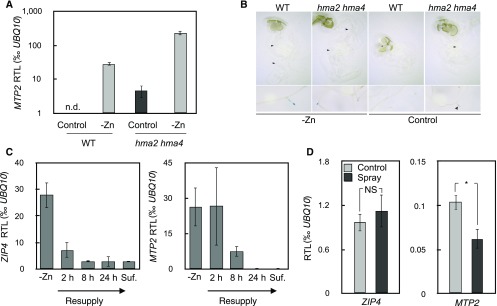Figure 2.
Root MTP2 Transcript Abundance Responds to Shoot Zn Status and Is Regulated at the Level of Promoter Activity.
(A) MTP2 transcript levels in roots of 19-d-old wild-type and hma2 hma4 seedlings cultivated on control and Zn-deficient (−Zn) agar-solidified media (n.d., not detected).
(B) GUS activity in wild-type and hma2 hma4 ProMTP2:GUS seedlings grown as in (A). Arrows indicate areas of GUS activity. Twenty independent ProMTP2:GUS transgenic lines were examined in the T2 generation. In the T3 generation, two representative homozygous lines were crossed into the hma2 hma4 background, and representative seedlings homozygous for the ProMTP2:GUS transgene and hma2 and hma4 mutations are shown.
(C) ZIP4 and MTP2 transcript levels in roots of 8-week-old hydroponically cultivated wild-type plants. Plants were transferred to Zn-sufficient (5 µM; Suf.) or Zn-deficient (0 µM added Zn; −Zn) hydroponic solutions for 3 weeks, or Zn (5 µM) was resupplied to −Zn-grown plants for the indicated periods of time, before harvest.
(D) ZIP4 and MTP2 transcript levels in roots of wild-type plants. Plants were cultivated in Zn-deficient hydroponic solutions for 4 weeks, followed by Zn resupply to rosettes as a foliar spray every 2 d for 14 d (Control: 0.01% [v/v] Triton X-100; Spray: 1 mM ZnSO4 in the same solution).
Bar graphs show arithmetic means ± sd (n = 4 technical replicates using tissue pooled from 3 replicate plates consisting of 16–18 seedlings each [A]; n = 4 technical replicates using cDNA pooled from 6 replicate hydroponic growth vessels, each containing 3 plants [C]; n = 5 technical replicates using tissue pooled from 13 replicate hydroponic vessels, each containing 2 plants each [D]). Asterisk indicates statistically significant difference between control and spray (P = 0.0013; Student’s t test). NS, not significant.

